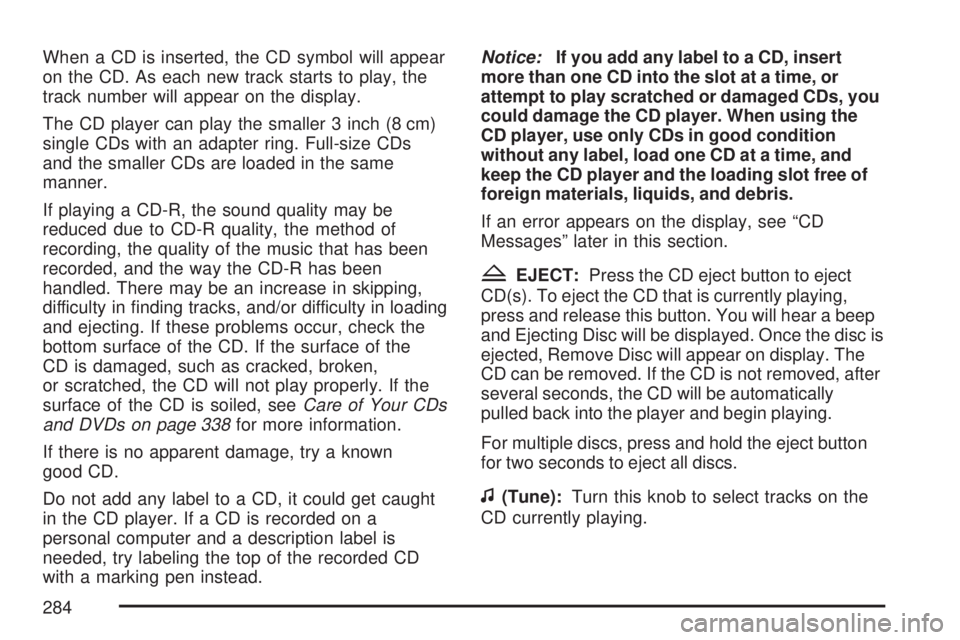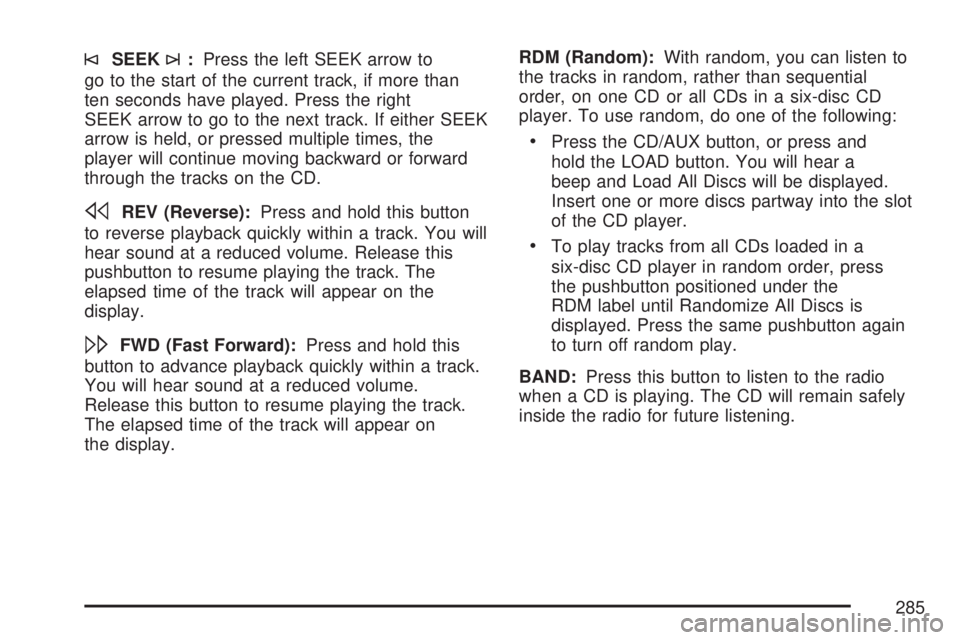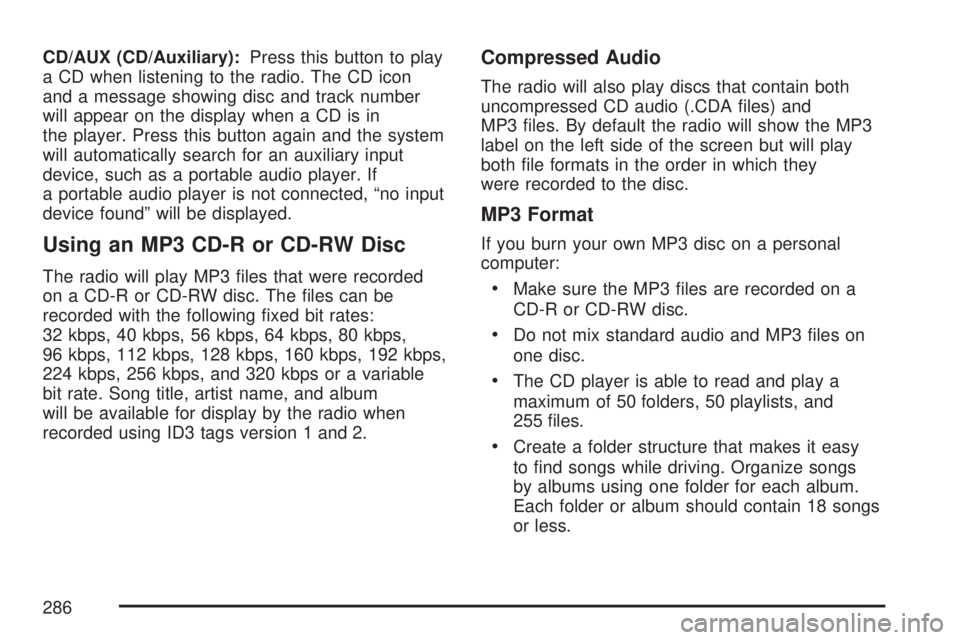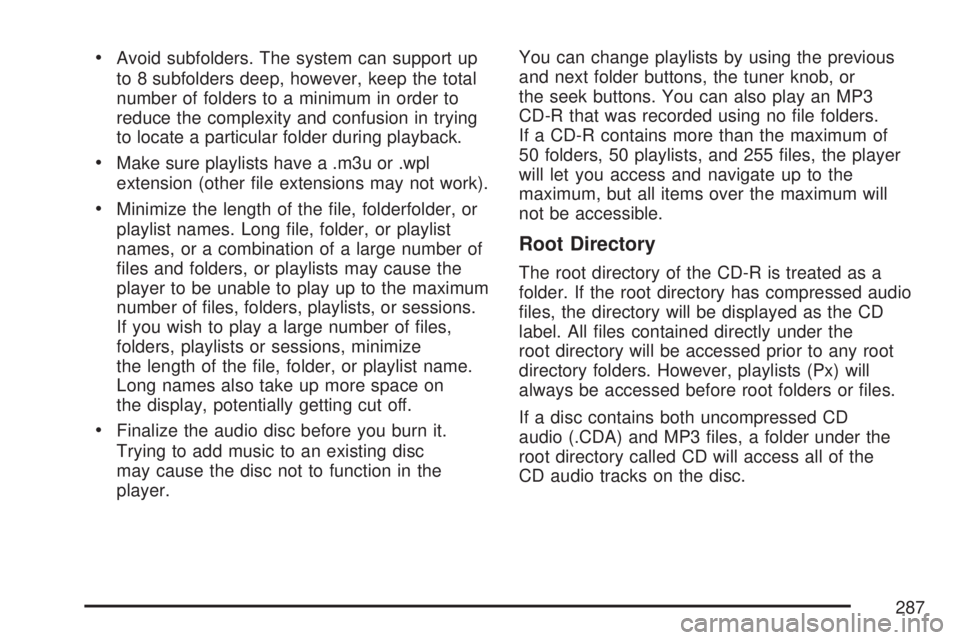display GMC YUKON 2007 Repair Manual
[x] Cancel search | Manufacturer: GMC, Model Year: 2007, Model line: YUKON, Model: GMC YUKON 2007Pages: 608, PDF Size: 3.06 MB
Page 284 of 608

When a CD is inserted, the CD symbol will appear
on the CD. As each new track starts to play, the
track number will appear on the display.
The CD player can play the smaller 3 inch (8 cm)
single CDs with an adapter ring. Full-size CDs
and the smaller CDs are loaded in the same
manner.
If playing a CD-R, the sound quality may be
reduced due to CD-R quality, the method of
recording, the quality of the music that has been
recorded, and the way the CD-R has been
handled. There may be an increase in skipping,
difficulty in �nding tracks, and/or difficulty in loading
and ejecting. If these problems occur, check the
bottom surface of the CD. If the surface of the
CD is damaged, such as cracked, broken,
or scratched, the CD will not play properly. If the
surface of the CD is soiled, seeCare of Your CDs
and DVDs on page 338for more information.
If there is no apparent damage, try a known
good CD.
Do not add any label to a CD, it could get caught
in the CD player. If a CD is recorded on a
personal computer and a description label is
needed, try labeling the top of the recorded CD
with a marking pen instead.Notice:If you add any label to a CD, insert
more than one CD into the slot at a time, or
attempt to play scratched or damaged CDs, you
could damage the CD player. When using the
CD player, use only CDs in good condition
without any label, load one CD at a time, and
keep the CD player and the loading slot free of
foreign materials, liquids, and debris.
If an error appears on the display, see “CD
Messages” later in this section.
ZEJECT:Press the CD eject button to eject
CD(s). To eject the CD that is currently playing,
press and release this button. You will hear a beep
and Ejecting Disc will be displayed. Once the disc is
ejected, Remove Disc will appear on display. The
CD can be removed. If the CD is not removed, after
several seconds, the CD will be automatically
pulled back into the player and begin playing.
For multiple discs, press and hold the eject button
for two seconds to eject all discs.
f(Tune):Turn this knob to select tracks on the
CD currently playing.
284
Page 285 of 608

©SEEK¨:Press the left SEEK arrow to
go to the start of the current track, if more than
ten seconds have played. Press the right
SEEK arrow to go to the next track. If either SEEK
arrow is held, or pressed multiple times, the
player will continue moving backward or forward
through the tracks on the CD.
sREV (Reverse):Press and hold this button
to reverse playback quickly within a track. You will
hear sound at a reduced volume. Release this
pushbutton to resume playing the track. The
elapsed time of the track will appear on the
display.
\FWD (Fast Forward):Press and hold this
button to advance playback quickly within a track.
You will hear sound at a reduced volume.
Release this button to resume playing the track.
The elapsed time of the track will appear on
the display.RDM (Random):With random, you can listen to
the tracks in random, rather than sequential
order, on one CD or all CDs in a six-disc CD
player. To use random, do one of the following:
Press the CD/AUX button, or press and
hold the LOAD button. You will hear a
beep and Load All Discs will be displayed.
Insert one or more discs partway into the slot
of the CD player.
To play tracks from all CDs loaded in a
six-disc CD player in random order, press
the pushbutton positioned under the
RDM label until Randomize All Discs is
displayed. Press the same pushbutton again
to turn off random play.
BAND:Press this button to listen to the radio
when a CD is playing. The CD will remain safely
inside the radio for future listening.
285
Page 286 of 608

CD/AUX (CD/Auxiliary):Press this button to play
a CD when listening to the radio. The CD icon
and a message showing disc and track number
will appear on the display when a CD is in
the player. Press this button again and the system
will automatically search for an auxiliary input
device, such as a portable audio player. If
a portable audio player is not connected, “no input
device found” will be displayed.
Using an MP3 CD-R or CD-RW Disc
The radio will play MP3 �les that were recorded
on a CD-R or CD-RW disc. The �les can be
recorded with the following �xed bit rates:
32 kbps, 40 kbps, 56 kbps, 64 kbps, 80 kbps,
96 kbps, 112 kbps, 128 kbps, 160 kbps, 192 kbps,
224 kbps, 256 kbps, and 320 kbps or a variable
bit rate. Song title, artist name, and album
will be available for display by the radio when
recorded using ID3 tags version 1 and 2.
Compressed Audio
The radio will also play discs that contain both
uncompressed CD audio (.CDA �les) and
MP3 �les. By default the radio will show the MP3
label on the left side of the screen but will play
both �le formats in the order in which they
were recorded to the disc.
MP3 Format
If you burn your own MP3 disc on a personal
computer:
Make sure the MP3 �les are recorded on a
CD-R or CD-RW disc.
Do not mix standard audio and MP3 �les on
one disc.
The CD player is able to read and play a
maximum of 50 folders, 50 playlists, and
255 �les.
Create a folder structure that makes it easy
to �nd songs while driving. Organize songs
by albums using one folder for each album.
Each folder or album should contain 18 songs
or less.
286
Page 287 of 608

Avoid subfolders. The system can support up
to 8 subfolders deep, however, keep the total
number of folders to a minimum in order to
reduce the complexity and confusion in trying
to locate a particular folder during playback.
Make sure playlists have a .m3u or .wpl
extension (other �le extensions may not work).
Minimize the length of the �le, folderfolder, or
playlist names. Long �le, folder, or playlist
names, or a combination of a large number of
�les and folders, or playlists may cause the
player to be unable to play up to the maximum
number of �les, folders, playlists, or sessions.
If you wish to play a large number of �les,
folders, playlists or sessions, minimize
the length of the �le, folder, or playlist name.
Long names also take up more space on
the display, potentially getting cut off.
Finalize the audio disc before you burn it.
Trying to add music to an existing disc
may cause the disc not to function in the
player.You can change playlists by using the previous
and next folder buttons, the tuner knob, or
the seek buttons. You can also play an MP3
CD-R that was recorded using no �le folders.
If a CD-R contains more than the maximum of
50 folders, 50 playlists, and 255 �les, the player
will let you access and navigate up to the
maximum, but all items over the maximum will
not be accessible.
Root Directory
The root directory of the CD-R is treated as a
folder. If the root directory has compressed audio
�les, the directory will be displayed as the CD
label. All �les contained directly under the
root directory will be accessed prior to any root
directory folders. However, playlists (Px) will
always be accessed before root folders or �les.
If a disc contains both uncompressed CD
audio (.CDA) and MP3 �les, a folder under the
root directory called CD will access all of the
CD audio tracks on the disc.
287
Page 288 of 608

Empty Directory or Folder
If a root directory or a folder exists somewhere
in the �le structure that contains only folders/
subfolders and no compressed �les directly
beneath them, the player will advance to the next
folder in the �le structure that contains compressed
audio �les and the empty folder will not be
displayed or numbered.
No Folder
When the CD-R contains only compressed �les,
the �les will be located under the root folder.
The next and previous folder functions will not be
displayed on a CD-R that was recorded without
folders or playlists.
When the CD-R contains only playlists and
compressed audio �les, but no folders, all �les
will be located under the root folder. The
folder down and the folder up buttons will search
playlists (Px) �rst and then go to the root
folder.
Order of Play
Tracks recorded to the CD-R will be played in the
following order:
Play will begin from the �rst track in the �rst
playlist and will continue sequentially through
all tracks in each playlist. When the last
track of the last playlist has been played, play
will continue from the �rst track of the �rst
playlist.
Play will begin from the �rst track in the �rst
folder and will continue sequentially through
all tracks in each folder. When the last track
of the last folder has been played, play
will continue from the �rst track of the �rst
folder.
When play enters a new folder, the display will not
automatically show the new folder name unless
you have chosen the folder mode as the
default display. The new track name will appear
on the display.
288
Page 289 of 608

File System and Naming
The song name that will be displayed will be the
song name that is contained in the ID3 tag. If
the song name is not present in the ID3 tag, then
the radio display will be blank following the
track indicator.
Preprogrammed Playlists
You can access preprogrammed playlists that
were created using WinAmp™, MusicMatch™,
or Real Jukebox™ software, however, you will not
have playlist editing capability using the radio.
These playlists will be treated as special folders
containing compressed audio song �les.
Playing an MP3
Wait for the message to insert a disc, label side
up. The player will pull it in, and the CD-R should
begin playing.
If you turn off the ignition or radio with a CD-R in
the player it will stay in the player. When you
turn on the ignition or radio, the CD-R will start to
play where it stopped, if it was the last selected
audio source.As each new track starts to play, the track number
and song title will appear on the display.
The CD player can play the smaller 3 inch (8 cm)
single CD-Rs with an adapter ring. Full-size
CD-Rs and the smaller CD-Rs are loaded in the
same manner.
If playing a CD-R, the sound quality may be
reduced due to CD-R quality, the method of
recording, the quality of the music that has been
recorded, and the way the CD-R has been
handled. There may be an increase in skipping,
difficulty in �nding tracks, and/or difficulty in loading
and ejecting. If these problems occur, check the
bottom surface of the CD. If the surface of the
CD is damaged, such as cracked, broken,
or scratched, the CD will not play properly. If the
surface of the CD is soiled, seeCare of Your CDs
and DVDs on page 338for more information.
If there is no apparent damage, try a known
good CD.
289
Page 290 of 608

Do not add any label to a CD, it could get caught
in the CD player. If a CD is recorded on a
personal computer and a description label is
needed, try labeling the top of the recorded CD
with a marking pen instead.
Notice:If you add any label to a CD, insert
more than one CD into the slot at a time, or
attempt to play scratched or damaged CDs, you
could damage the CD player. When using the
CD player, use only CDs in good condition
without any label, load one CD at a time, and
keep the CD player and the loading slot free of
foreign materials, liquids, and debris.
If an error appears on the display, see “CD
Messages” later in this section.
ZEJECT:Press the CD eject button to eject
CD-R(s). To eject the CD-R that is currently playing,
press and release this button. You will hear a beep
and Ejecting Disc will be displayed. Once the disc is
ejected, Remove Disc will appear on display.
The CD-R can be removed. If the CD-R is not
removed, after several seconds, the CD-R will be
automatically pulled back into the player and begin
playing. For multiple discs, press and hold the eject
button for two seconds to eject all discs.
f(Tune):Turn this knob to select MP3 �les on
the CD-R currently playing.
©SEEK¨:Press the left SEEK arrow to go to
the start of the current MP3 �le, if more than
ten seconds have played. Press the right SEEK
arrow to go to the next MP3 �le. If either
SEEK arrow is held or pressed multiple times, the
player will continue moving backward or forward
through MP3 �les on the CD.
Sc(Previous Folder):Press the pushbutton
positioned under the Folder label to go to the
�rst track in the previous folder.
cT(Next Folder):Press the pushbutton
positioned under the Folder label to go to the �rst
track in the next folder.
sREV (Reverse):Press and hold this button to
reverse playback quickly within an MP3 �le. You will
hear sound at a reduced volume. Release this
button to resume playing the �le. The elapsed time
of the �le will appear on the display.
290
Page 291 of 608

\FWD (Fast Forward):Press and hold this
button to advance playback quickly within an MP3
�le. You will hear sound at a reduced volume.
Release this button to resume playing the �le.
The elapsed time of the �le will appear on
the display.
RDM (Random):With random, you can listen to
MP3 �les on the CD-R in random, rather than
sequential order, on one CD-R or all discs
in a six-disc CD player. To use random, do one of
the following:
1. To play MP3 �les from the CD-R you are
listening to in random order, press the
pushbutton positioned under the RDM label
until Random Current Disc is displayed.
Press the same pushbutton again to turn off
random play.
2. To play songs from all CDs loaded in random
order, press the pushbutton positioned under
the RDM label until Randomize All Discs
is displayed. Press the same pushbutton again
to turn off random play.h(Music Navigator):Use the music navigator
feature to play MP3 �les on the CD-R in order
by artist or album. Press the pushbutton located
below the music navigator label. The player
will scan the disc to sort the �les by artist and
album ID3 tag information. It may take several
minutes to scan the disc depending on the number
of MP3 �les recorded to the CD-R. The radio
may begin playing while it is scanning the disc
in the background. When the scan is �nished, the
CD-R will begin playing again.
Once the disc has been scanned, the player will
default to playing MP3 �les in order by artist.
The current artist playing is shown on the
second line of the display between the arrows.
Once all songs by that artist are played, the player
will move to the next artist in alphabetic order
on the CD-R and begin playing MP3 �les by that
artist. If you want to listen to MP3 �les by
another artist, press the pushbutton located below
either arrow button. You will go to the next or
previous artist in alphabetic order. Continue
pressing either button until the desired artist is
displayed.
291
Page 292 of 608

To change from playback by artist to playback by
album, press the pushbutton located below the
Sort By label. From the sort screen, push one of
the buttons below the album button. Press the
pushbutton below the back label to return to the
main music navigator screen. Now the album
name is displayed on the second line between the
arrows and songs from the current album will
begin to play. Once all songs from that album are
played, the player will move to the next album
in alphabetic order on the CD-R and begin playing
MP3 �les from that album.
To exit music navigator mode, press the
pushbutton below the Back label to return to
normal MP3 playback.
BAND:Press this button to listen to the radio
when a CD is playing. The CD will remain safely
inside the radio for future listening.CD/AUX (CD/Auxiliary):Press this button to play
a CD when listening to the radio. The CD icon
and a message showing disc and/or track number
will appear on the display when a CD is in the
player. Press this button again and the system will
automatically search for an auxiliary input device
such as a portable audio player. If a portable audio
player is not connected, “no input device found”
will be displayed.
CD Messages
CHECK DISC:If this message appears on the
display and/or the CD comes out, it could be
for one of the following reasons:
It is very hot. When the temperature returns to
normal, the CD should play.
You are driving on a very rough road.
When the road becomes smoother, the CD
should play.
The CD is dirty, scratched, wet, or
upside down.
292
Page 293 of 608

The air is very humid. If so, wait about an
hour and try again.
There may have been a problem while
burning the CD.
The label may be caught in the CD player.
If the CD is not playing correctly, for any other
reason, try a known good CD.
If any error occurs repeatedly or if an error cannot
be corrected, contact your dealer. If the radio
displays an error message, write it down
and provide it to your dealer when reporting the
problem.
Using the Auxiliary Input Jack
Your radio system has an auxiliary input jack
located on the lower right side of the faceplate.
This is not an audio output; do not plug the
headphone set into the front auxiliary input jack.
You can however, connect an external audio
device such as an iPod, laptop computer, MP3
player, CD player, or cassette tape player, etc.
to the auxiliary input jack for use as another source
for audio listening.To use a portable audio player, connect a 3.5 mm
(1/8 inch) cable to the radio’s front auxiliary
input jack. When a device is connected, press the
radio CD/AUX button to begin playing audio
from the device over the car speakers.
O(Power/Volume):Turn this knob clockwise to
increase or counterclockwise to decrease the
volume of the portable player. You may need to
do additional volume adjustments from the portable
device if the volume does not go loud or soft
enough.
BAND:Press this button to listen to the radio
when a portable audio device is playing. The
portable audio device will continue playing, so you
may want to stop it or turn it off.
CD/AUX (CD/Auxiliary):Press this button to play
a CD when a portable audio device is playing.
Press this button again and the system will begin
playing audio from the connected portable
audio player. If a portable audio player is not
connected, “no input device found” will be
displayed.
293